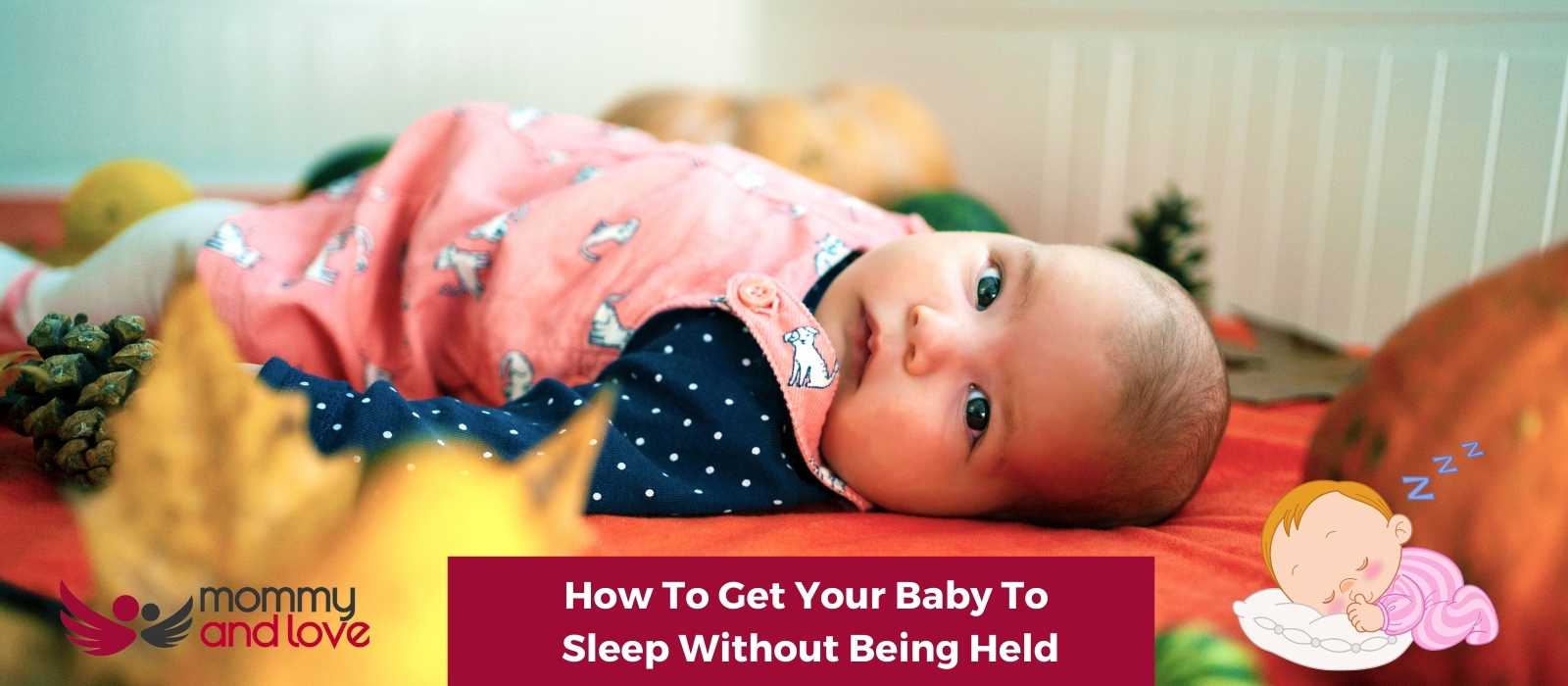There are many ways to get your baby to sleep without being held including putting a baby down drowsy but awake, using a white noise machine, creating a safe sleep environment, using a smart sleeper and many more.
Affiliate Disclaimer: As an Affiliate, we earn from qualifying purchases.
Why Do Some Infants Want to Be Held While Falling Asleep?
If your baby falls asleep while nursing, don’t panic. This is perfectly normal for most breastfed babies.
Most nursing infants in the newborn stage want to be held while sleeping because they feel safer and more comfortable that way. It helps regulate their temperature and lowers their blood pressure thus putting them to sleep.
Newborns are still getting used to life outside of the womb, and they might want to be held or have body contact with their parents all night long.
Being held close to a caregiver allows a child to hear your heartbeat and smell your scent, which can make them feel more relaxed and secure thus making sleeping easier for them.
If your child seems to be particularly fussy, try holding them close while they are sleeping and see if it makes a difference.
Do Infants Sleep Better When Held?

Infants tend to sleep better when they are held because they feel more secure and safe.
When they are held, they know that someone is there for them and they feel comforted. This helps them to relax and sleep more easily.
Additionally, being held helps infants to regulate their stress levels and autonomic functions, which can also contribute to a better night’s sleep.
Do Infants Outgrow Being Held to Sleep?
It’s not uncommon for young children to fall asleep while being held by their parents or caregivers. In fact, it can be a comforting and enjoyable experience for both you and your baby.
However, there may come a time when the baby outgrows this need and is able to fall asleep on his or her own. For some infants, this transition occurs seamlessly. But in other cases, parents find that their baby may need some assistance in learning how to sleep independently.
Can Babies Fall Asleep Alone?
In time, your children will learn to fall asleep on their own. However, your children might not be able to do this without your help and assistance.
Children have different sleep needs and some will take to independent sleep habits more easily than others. Sleep training can help children learn how to fall asleep and stay asleep on their own, but it’s important to do so in a way that is safe and healthy for both baby and parent. We’ve done a guide to When To Start Sleep Training
When to Stop Holding or Nursing Baby to Sleep?
Every baby is different, and each parent knows their own child best. One method might work for some parents but it doesn’t mean it will work for other moms and dads.
There are some general guidelines that can help parents make the decision of getting their infants to get used to the idea of falling asleep without nursing.
Ideally, parents should stop nursing their newborns to sleep when they are able to sleep through the night without needing to be fed. This is typically around the 6-month mark but could be earlier or later depending on the baby.
If your infants fall asleep nursing, it is important for them to learn the skill of falling asleep without nursing which can help them become independent sleepers. While it is difficult to break negative sleep associations, you can be successful with patience and consistency.
Most children develop a form of sleep association. This is normal and it is only a problem if your infant can’t sleep without them. For instance, if your baby develops a need for nursing or rocking to help him sleep, it can eventually result in a sleep association.
As your new baby grows older, you will have to break her from these sleep associations. Otherwise, it would be difficult for an older baby to sleep without them.
How to Get Babies to Sleep Without Being Held
There are a few tricks to getting older babies to sleep without being held.
Here are a few of them:
Sleep Training
Young children will eventually learn how to sleep on their own but sleep training can make it easier for them.
Sleep coaching or training is a method of teaching infants to sleep without nursing. This can be done through a variety of methods, such as using a pacifier, putting them in a crib, or using a baby monitor. It is important to start sleep training as early as possible to get the best results.
There are many ways to sleep train a baby and parents should choose what they think is best for their infants based on their mothering style. One key element of teaching young children to sleep is putting baby to sleep drowsy but still awake at night.
Sleep training often involves controlled crying such as the cry it out method but there are also methods that are considered low-cry which means fewer tears for your baby if you can’t simply watch your baby cry it out until he gets tried and eventually sleeps at night.
Another particular skill young children will learn through these training methods is the ability to self-soothe. Self-soothing is the ability of young children to put themselves back to sleep when they wake up in the middle of the night.
Follow a Consistent Bedtime Routine

Most babies thrive on a consistent bedtime routine. Developing a routine can help baby sleep and know what to expect and help them relax and fall asleep more easily.
Some tips to create a bedtime routine include having the same order of events each night, keeping rituals short and simple, and avoiding activities that stimulate the baby right before bedtime.
Following a bedtime or naptime routine will help the baby learn that sleep is coming and can help the baby feel more relaxed and sleepy.
Get Your Baby on a Regular Nap and Sleep Schedule
Young infants need a lot of sleep, and establishing a regular nap and sleep schedule helps ensure that they get the rest they need. Having a set routine also helps infants feel more secure and calm, which can make it easier for them to fall asleep on their own.
There are a few different things you can do to help your baby follow a regular schedule:
- Wake your baby up at the same time each day. This helps to establish a regular sleep pattern.
- Put your baby down for naps at the same time each day. Naps should be spaced evenly throughout the day, with the last nap ending at least 3 hours before bedtime.
- Put your baby to bed at the same time each night. A consistent bedtime helps signal to your baby that it’s time to sleep.
Establishing a regular sleep schedule can take some time and patience, but it will be worth it in the end. Once your baby is on a schedule, you can start working on getting them to sleep on their own.
Gradually Wean From the Amount of Touch
Most newborns need a lot of touches to feel secure and fall asleep. As they get older, they can learn to sleep without being held if you gradually wean them off from the amount of touch they receive.
This can be done by decreasing the amount of time they spend in your arms and increasing the amount of time they spend in their crib or bassinet. You can also put your baby in her crib awake but drowsy or keep your baby awake during your usual nursing session.
Follow Age-appropriate Awake Windows
One way to get young babies to sleep without being held is to follow age-appropriate awake windows. By keeping track of your baby’s awake windows, you can help them learn how to fall asleep on their own.
During the day, allow your baby to stay awake for periods of time that are appropriate for their age, and put them to bed when they start to show signs of fatigue. For example, a newborn should only be awake for about 45 minutes at a time, while a 3-month-old can remain awake for up to 2 hours.
You can also use your baby’s awake windows to determine the right time for nursing or feeding. You can offer nighttime feeding as soon as your baby wakes up from her nap or sleep. Feeding your baby soon after waking up helps keep them from falling asleep during nighttime feeds since they won’t be hungry enough to nurse again by the time their next nap comes around.
Utilize the Eat, Play, Sleep Routine

When you establish an eat, play, sleep routine for your baby, it will help her to sleep better at night. By following a specific schedule, your baby will know what to expect and will be more likely to fall asleep on her own.
Additionally, by eating and playing during her awake time, she will be tired and ready for bed when it’s time for her nap.
To start, you will need to establish a regular feeding schedule. It is best to feed your baby every 2-3 hours during the day. You can then follow each feeding with some playtime. After about an hour of play, it is time for your baby’s nap. Create a wind-down time by dimming the lights and putting on calming music. Once she wakes up from her nap, feed her again and then let her play until it is time for bed.
If you stick to this routine, she’ll learn quickly when it is time to eat, play, and sleep. Additionally, she will be more likely to sleep through the night and even get more sleep with the new routine because she will be tired from a full day of activities.
If you’re breastfeeding, makes sure you keep up with your milk production to make sure you have enough breast milk for your feeding time.
Use a Smart Sleeper or Rocking Bassinet
The advances in technology mean that many smart cribs can now take the place of parents for rocking and lulling a baby to sleep. Smart sleepers, like the SNOO, automatically turn on when they sense your baby stirring.
Dr. Harvey Karp, author of Happiest Baby on the Block, invented the SNOO Bassinet. It’s a clever bassinet that employs mild side to side rumbling movements and plays white noise to help your infant sleep better and self-soothe. The Snoo’s software allows you to modify the motion and white noise sounds using an app. To utilize the program, you must first connect your Snoo to Wi-Fi.
The SNOO is an amazing sleep product and we’ve had great success using it with our son. But it is expensive to buy and you may only use it for a few months. If you are looking for a more affordable option, I recommend the renting the SNOO, which costs just few dollars a day.
Rocking bassinets are another option that can help soothe your baby to sleep. These bassinets have a gentle rocking motion that can help lull your baby to sleep. Additionally, many rocking bassinets come with built-in white noise players that can help to soothe your baby even further. We’ve done the best rocking bassinets guide. It’s worth reading our When to Stop Rocking Baby to Sleep guide.
Don’t Let Your Baby Get Overtired
When a baby gets overtired, they can get fussy and won’t want to sleep due to stress hormones flooding their bloodstream. This is why it’s important to keep an eye on their sleep schedule and make sure they’re not getting too much stimulation during the day. How To Help An Overtired Baby Catch Up On Sleep
Make sure they have plenty of time to nap and avoid keeping them up for too long. If your baby does get overtired, try to soothe them with a calm voice and gentle rocking until they drift off to sleep.
Create a Safe Sleep Environment
One of the best ways to make an infant sleep without comfort nursing or being held is to create a safe sleep environment. This means making sure that the baby’s crib is free of hazards such as bumpers, stuffed animals, and blankets. The crib should also be at the right height for parents and babies, and the mattress should be firm.
Parents should avoid using pillows, as these can be a suffocation hazard.
In addition to making the crib safe, parents should also create a dark and quiet environment for the baby to sleep in. This means turning off any lights or electronics in the room and using a white noise machine to help muffle any outside noise. Newborns should sleep in a dark room.
These things can help put your baby into deep sleep easily. Remember babies are not afraid of the dark.
Young children should also not sleep in their car seats or swings for extended periods of time, as these are not safe sleep environments.
Creating a safe and dark sleep environment will help young children sleep more soundly and for longer periods of time. This will help many parents get the unbroken sleep and the rest they need, and it will also allow the child to develop good sleep habits.
Conclusion on How to Get Newborn to Sleep Without Being Held
If you are struggling to get your baby to sleep without being held, don’t worry, you are not alone. There are many different ways to help a child sleep without being held. Try some of the methods we have suggested and see which one works best for you and your baby.

This article was written by: Gian MIller – Full-Time Writer, Baby Whisperer & Dad of 3.
Gian spends a lot of his time writing. A self-proclaimed baby whisperer, Gian has been through it all with his own children and is passionate about sharing his hard-won wisdom with other parents. When he’s not writing or changing diapers, you can find him playing the guitar or watching baseball (or preferably both at the same time).




